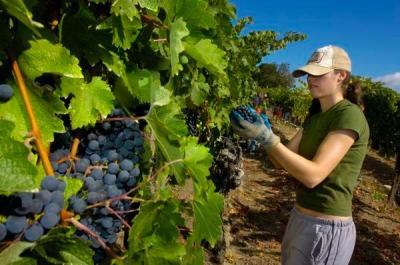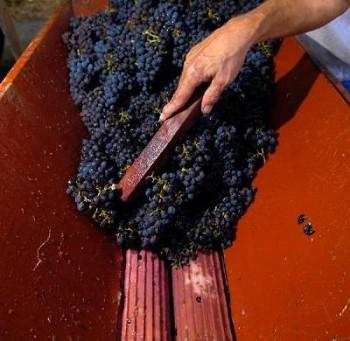Marin experiences an early but fruitful harvest
Nancy Isles Nation
Marin Independent Journal
September 18, 2007

It's harvest time at many of Marin's vineyards and vintners say the crop is high in quality if perhaps a little low in quantity.

"The crop was way ahead of schedule," said Debbie Rowland of Pacheco Ranch Winery in Ignacio, who picked cabernet sauvignon grapes over the past two Saturdays. "The quantity is down about 20 percent from the usual 10 tons but the grapes taste great."
Marin has 171 acres of wine grapes in production, which is up from 108 acres a year ago. It's just a small part of the agriculture sector in the county but it's an important one because of the character of the grapes.
The value of its 2006 crop climbed to $600,000 from $265,000 in 2005, according to county agricultural commissioner Stacy Carlsen.
"Some of that crop has been growing and is now coming into production," Carlsen said.
Winemaker Craig Roemer from Schramsberg Vineyards in Calistoga blends Marin grapes into virtually all of his sparkling wines.
"It gives structure to the wine because the season is so late in Marin and it produces a more robust grape flavor and acid," Roemer said. "Realistically, they add an acid backbone."
In fact, Schramsberg is buying grapes from just one Marin vineyard. The other five the vintner buys from are not ready for harvest yet. Meanwhile, Napa, Sonoma and Mendocino counties have already harvested most of their grapes for sparkling wines.
"Some of the top-notch Marin fruit finds its way into J Schram and the reserve," Roemer said, adding that he might be able to blend an all-Marin sparkling wine this year. The J Schram is a premium sparkler made with chardonnay grapes, and the Schramsberg Reserve is based on pinot noir.
Schramsberg started buying Marin grapes in 1998 from Mark Pasternak's Devil's Gulch vineyard on the hills overlooking Nicasio. Roemer said he has tip-toed into some other vineyards since but can only buy what is available because Marin berries have been discovered.
"We were hoping to keep it a secret," Roemer said. "I'd love to get all of the fruit in Marin."
Pasternak, a vineyard manager, leases the Corda Winery property on Chileno Valley Road near the Marin-Sonoma border, where he grows pinot noir for Schramsberg. At Devil's Gulch he produces pinot noir, chardonnay and a small amount of gewurztraminer.
He attributes this year's early harvest in Marin to the dry, warm winter. He is staging harvest at various vineyards ahead of the usual schedule.
"It is unusual to do all the picking in September," Pasternak said. "So far, everybody is saying the quality is high."
Jonathan Pey, whose labels include Pey-Marin and Mount Tamalpais, has started harvesting at his vineyards in northwest Nicasio and on Chileno Valley Road after what he called a "spectacular" growing season.
He expects to reap about 1.75 tons of grapes per acre rather than the two tons he gets in a typical year. In comparison, vineyards in the Carneros region and other parts of Sonoma produce about four tons per acre.
While the pinot and merlot grapes are ready, Pey said he probably will not pick his riesling grapes until October.
He said it is the climate and soil that makes Marin grapes special.
"It's a little warmer than other grape areas so the vine starts its new season a little earlier," Pey said. "Then we have a really cold growing season."
With an earlier start and longer season, the grapes have longer to develop a deep flavor.
As for the soil, Pey said West Marin is made up of a lot of porous sandstone so the roots are forced to grow deep and soak up rich minerals and other nutrients.
Coastal vineyards are the last to harvest in Marin because they have the coolest temperatures. Point Reyes Vineyard, for instance, won't begin picking grapes until October.
The grapes from the coast are especially suited to sparkling wines because they are high in acid and modest in sugar.
"Where the grapes are grown is really important," Pey said. "In Marin, a good portion are organically farmed and sustainably farmed."
Read more Business and stocks stories at the IJ's Business and stocks page.
Contact Nancy Isles Nation via e-mail at nnation@marinij.com



